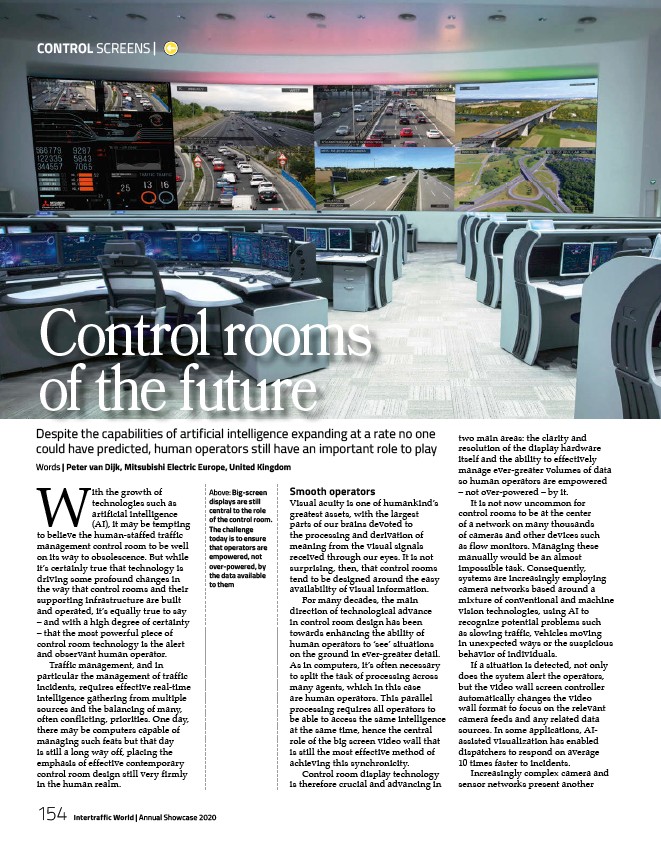
CONTROL SCREENS |
Despite the capabilities of artificial intelligence expanding at a rate no one
could have predicted, human operators still have an important role to play
Words | Peter van Dijk, Mitsubishi Electric Europe, United Kingdom
Above: Big-screen
displays are still
central to the role
of the control room.
The challenge
today is to ensure
that operators are
empowered, not
over-powered, by
the data available
to them
With the growth of
technologies such as
artificial intelligence
(AI), it may be tempting
to believe the human-staffed traffic
management control room to be well
on its way to obsolescence. But while
it’s certainly true that technology is
driving some profound changes in
the way that control rooms and their
supporting infrastructure are built
and operated, it’s equally true to say
– and with a high degree of certainty
– that the most powerful piece of
control room technology is the alert
and observant human operator.
Traffic management, and in
particular the management of traffic
incidents, requires effective real-time
intelligence gathering from multiple
sources and the balancing of many,
often conflicting, priorities. One day,
there may be computers capable of
managing such feats but that day
is still a long way off, placing the
emphasis of effective contemporary
control room design still very firmly
in the human realm.
154 Intertraffic World | Annual Showcase 2020
Smooth operators
Visual acuity is one of humankind’s
greatest assets, with the largest
parts of our brains devoted to
the processing and derivation of
meaning from the visual signals
received through our eyes. It is not
surprising, then, that control rooms
tend to be designed around the easy
availability of visual information.
For many decades, the main
direction of technological advance
in control room design has been
towards enhancing the ability of
human operators to ‘see’ situations
on the ground in ever-greater detail.
As in computers, it’s often necessary
to split the task of processing across
many agents, which in this case
are human operators. This parallel
processing requires all operators to
be able to access the same intelligence
at the same time, hence the central
role of the big screen video wall that
is still the most effective method of
achieving this synchronicity.
Control room display technology
is therefore crucial and advancing in
two main areas: the clarity and
resolution of the display hardware
itself and the ability to effectively
manage ever-greater volumes of data
so human operators are empowered
– not over-powered – by it.
It is not now uncommon for
control rooms to be at the center
of a network on many thousands
of cameras and other devices such
as flow monitors. Managing these
manually would be an almost
impossible task. Consequently,
systems are increasingly employing
camera networks based around a
mixture of conventional and machine
vision technologies, using AI to
recognize potential problems such
as slowing traffic, vehicles moving
in unexpected ways or the suspicious
behavior of individuals.
If a situation is detected, not only
does the system alert the operators,
but the video wall screen controller
automatically changes the video
wall format to focus on the relevant
camera feeds and any related data
sources. In some applications, AIassisted
visualization has enabled
dispatchers to respond on average
10 times faster to incidents.
Increasingly complex camera and
sensor networks present another
Control rooms
of the future